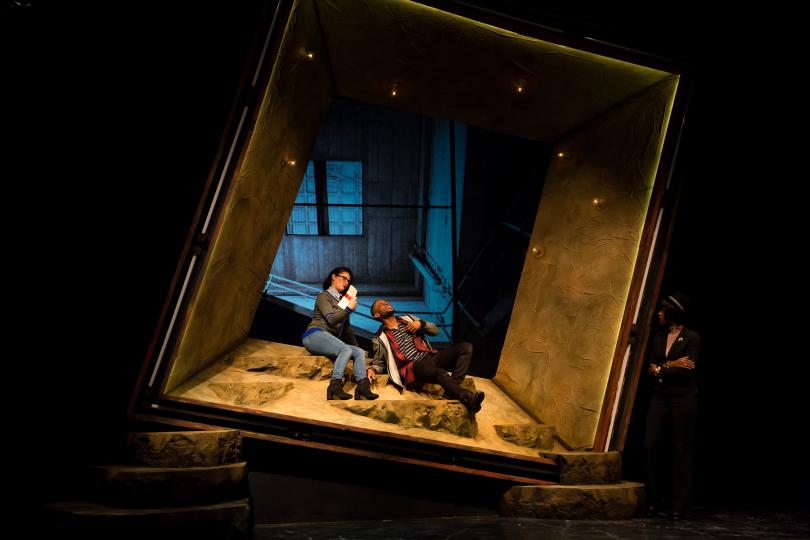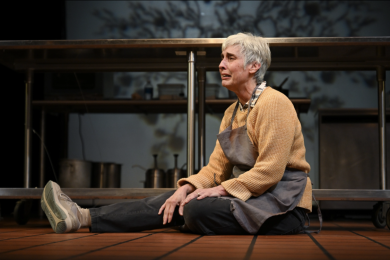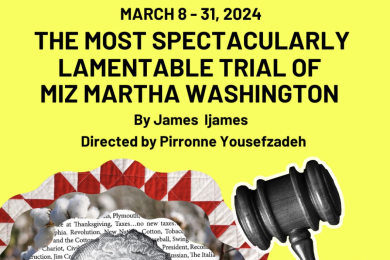Cinematic Dane

“I think Hamlet's tragedy is that he's the sanest person in the play,” says Joel Sass, director of Park Square Theatre's contemporary take on the William Shakespeare classic. “He's the one who is the most introspective, the one who has a clear sight when everyone else is falling into line behind a new regime. He's a little too sane, and that can be dangerous to somebody in power.”
His dynamic, two-hour-twenty-minute version of Hamlet features a small cast of nine actors and is a scaled-down adaptation of the original text, which typically runs closer to four hours in unedited form. Peripheral characters like Fortinbras and Rosencrantz & Guildenstern are omitted, although their absence serves to foreground the central conflict.
Sass describes it as a more cinematic interpretation of Shakespeare's play:
“For me it has to do with how much velocity one scene overtakes another. We're trying to move from scene-to-scene with the language of jump cuts and dissolves. In film and television, things can be done very evocatively, but with more brevity. The uncut Hamlet is everything except brief, and part of the joy of watching an uncut Hamlet is that deep immersion. That's a great experience to have, but on the opposite end of the spectrum, if you wanted something that has more precision or concision, editing that script so it reads more like a screenplay is a way to get at a different audience experience.”
Sass explained one of this production's key influences:
“I think in terms of mood and atmosphere, House of Cards was something that we talked about a lot. We're after a sort of political thriller vibe, versus something that is luxuriating in reproducing antique Europe, but we don't want to get bogged down in the modern kitsch of 'Oh look, everyone's using their cell phone and their iPad.'”
The nine-person performing ensemble is comprised of Twin Cities actors, both veterans and newcomers, with diverse experience in the theatrical world.
“One of the beauties of Park Square is that they exist to cultivate, nurture, and showcase local talent. So it was very much on my mind to look at the wide tapestry of folks who were auditioning for the show and try to find a group that would be inclusive and representative of the contemporary world, but also some of the best established actors we've got, and some of the really interesting younger talent that's coming on to the scene that would benefit from the experience of wrestling with this play's language in a professional production.”
The titular Dane is played by Kory LaQuess Pullam, a rising star in the local theater community both in front of audiences and behind the scenes as a playwright. Sass talked about casting Pullam in the lead role:
“Kory came in and gave a pretty persuasive audition, and he had a lot of passion and heart. He has an emotional warmth that I felt helped balance some of the more chilly cerebral and melancholic aspects that are traditionally associated with the character—some folks go, 'Yeah, Hamlet can seem really remote or even cold'. I was really interested to explore this role with an actor who already has an embodied warmth, where he has volatility but also a certain vulnerability.”
Notably, Park Square's Hamlet features several traditionally-male roles re-imagined as female characters (for example, Polonius is Polonia in this version).
“Especially over the last decade or so, I've been really conscious of the responsibility I've got as a project leader to help shape who's in the room. There's definitely some disparity with who often gets featured onstage, especially when you're doing Shakespeare plays and especially when you then reduce the cast size. So I knew going into it that I wanted to find opportunities to do some gender-flipping in the show. Because I feel there's too much good talent out there to be sidelined on the bench just because their gender doesn't match the original description of the role, but also because I think: 'Who's out there in the audience watching this stuff?'--sometimes it's almost more women than men in your ticket-buying audience, and I feel I owe it to the audience and to our contemporary culture to broaden the notion of who can portray these parts.”
Sass is also responsible for Hamlet's minimalist scenic design: along with a stationary chandelier, the set is dominated by a massive hollow cube, which serves as both a focal point for the action and a frame for background projections meant to evoke modern Scandinavia.
“That's where we worked a lot with [video designer] Kathy Maxwell: let's explore a lot of Brutalist concrete architecture and see what the windows through that cube might be, into other interior or exterior spaces. She's good at devising vocabulary for how we would transition from place-to-place, so that concrete cube tipped on its side is kind of like a lens or interior psychological brain-box for Hamlet.
The director talked about realizing the setting of Hamlet, described in the playbill as “Denmark, a state of mind”:
“There was a sense of, 'Where is Denmark?' Even back in Shakespeare's day, the Denmark he is describing doesn't really correspond with actual geography. Even though it's based on some historical antecedents that are Danish in origin, the point of the play is not that it's history or a documentary—it's describing a certain country that's in a precarious position. I like to find a middle-ground between honoring a timeless sense of a country we're calling 'Denmark' that has a monarchy, and with a portrayal that feels a bit more contemporary: Washington, or the UK, or the Hague, or a modern European political environment.”
Park Square Theatre's Hamlet continues its run through November 11, after which Joel Sass will be working with the nearby History Theatre on an upcoming production.




